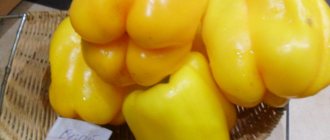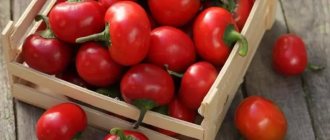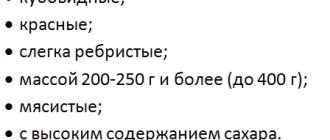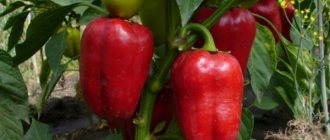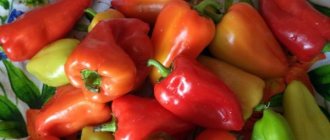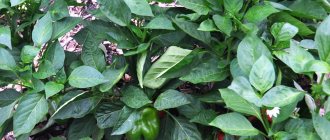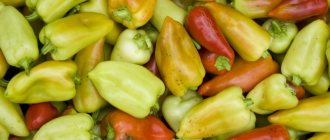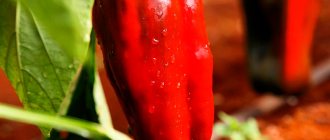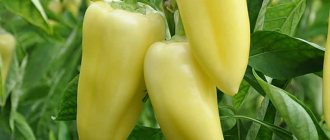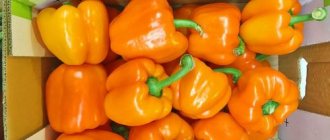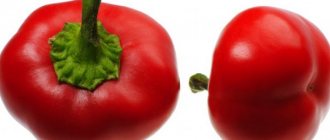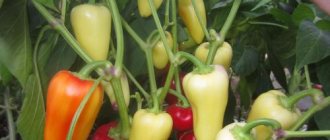Sweet pepper Kubyshka belongs to the group of early ripening ones; it has proven itself well in the northern regions, even in the high mountain regions of the Urals. Suitable for growing both in greenhouses and in open ground.
The time of growth and maturation, from seedling germination to ripeness, is 100-120 days.
The Kubyshka pepper bush is spreading and tall. The average height of the stem reaches one meter; in some places bushes with a height of 120 cm are noted.
The fruits are large, directed downwards, cylindrical dome-shaped, wide, almost square. The color at full biological maturity is dark red. The skin of ripe peppers is shiny and smooth. The average fruit weight reaches 250-300 g. The pulp is juicy, the wall thickness is up to 10 mm. Productivity, subject to good care and compliance with all agrotechnical measures, reaches 5-6 kg per m2.
Characteristics of the variety
Kubyshka is an early-ripening variety of bell pepper for growing in open ground and greenhouse conditions. The bush is tall (1 - 1.2 m), has a spreading shape. Ripe fruits are cone-shaped, large, and at the ripe stage acquire a dark red color and shiny skin. The fruits reach a weight of 240–250 g and are perfect for eating in any form: both fresh and pickled. With proper care and attention, you can collect up to 6 kg of juicy and bright fruits from each bush.
Pepper “Kubishka” variety description and characteristics
The “Kubishka” pepper variety is one of those that ripen in a short period of time after planting. This early-ripening variety bears fruit within 100–105 days after planting.
Once fully ripe, the vegetable has a bright red color. The taste is sweet, pleasant and the flesh is quite juicy and dense. The fruits are of medium size, and the average weight reaches no more than 250 grams. The shape of the fruit is cylindrical, almost square. The walls reach a thickness of about 10 mm, which is a good indicator. The harvest period occurs at the end of summer and beginning of autumn. High yield - approximately 6 kilograms per 1 m2.
The high content of vitamins such as beta-carotene and vitamin C make this fruit a great find for boosting immunity.
Pepper also has a beneficial effect on the structure of hair and nails and improves skin condition. Additional beneficial properties include improved digestion, thins the blood, and according to recent data, scientists have found that P-coumaric and chlorogenic acids prevent the development of cancer cells. An interesting fact is that the highest concentration of beneficial substances is found in the pepper seeds and near its stalk. Important! Bell peppers should be consumed with caution by those who have problems with heart rhythm, people with gastritis, colitis and high acidity. This fruit is also contraindicated for people with epilepsy.
Preparing seeds before sowing
Seeds are sown at the end of February approximately 70 days before the intended planting of seedlings in a permanent place. Soak the seeds for 2 days in warm water, then it is useful to keep them for several hours in a weak solution of potassium permanganate and rinse with running water. Pour soil into small containers and water. Pour in the pre-soaked seeds and cover with a 1 cm layer of dry soil. Place the containers in a sunny, well-lit place at a temperature of 27-28 °C. It is advisable to cover the containers with transparent material to speed up seed germination, which sometimes needs to be removed for ventilation. On the third day of sprouting, the transparent material is completely removed, since accumulated condensation can cause plant disease.
Features of agricultural technology
To grow the crop, the seedling method is chosen. Capsicum pepper requires compliance with the basic rules of planting and care:
- Before sowing, the seeds are germinated;
- Before moving to the garden bed, the seedlings are kept at a temperature of 15 – 22 degrees;
- pepper is transferred to the ground when the seedlings reach the age of 65 days;
- the soil temperature at the time of planting should reach more than 10 degrees;
- the ground under the bushes is irrigated once every 3 days;
- pepper is fed every 15 - 20 days;
- all plants are strengthened with a garter to supports;
- The principle of culture formation is 2 – 3 main stems.
Advice. Peppers should be transplanted into the garden bed along with a lump of earth surrounding the roots. The root collar should not be buried in the soil.
Sowing seeds for seedlings | Planting seedlings in a greenhouse/greenhouse | Planting seedlings in exhaust gas | Stepsoning | Harvesting |
| From February 20 to March 10 | The end of May | The beginning of June | Elimination of shoots up to the main fork, formation of 2 – 3 stems | Second half of July - September |
| *dates are indicated for central Russia | ||||
Picking up seedlings
At the end of April, when the first leaves begin to appear on the sprouts, the seedlings must be transplanted into containers with a volume of up to 0.5 liters. At this time, the spine has the shape of a rod and will be able to easily transfer the “moving” to a new place. The sprouts are removed from their original place with clods of earth and transplanted into new soil. Water with caution - in the case of Kubyshka pepper, it is better not to add water to the soil than to over-moisten it.
3 weeks after diving, it is useful to harden the seedlings - for this you can take the containers out into the open air for several hours. And just before planting in open ground, it can be left even overnight.
Diseases and pests
Care will protect you from pests and diseases.
Peppers are susceptible to fungal diseases. Also, they are not protected from pests.
Diseases
There are many different diseases that can affect peppers. Let's look at the most serious diseases:
- Verticillium - appears together with verticillium fungi. They penetrate the plant through the roots. Mushrooms suck out the juices of the plant and poison it. The most unpleasant thing about this disease is that when the first symptoms appear, it is already too late to save the bush, since it will be sufficiently damaged. Symptoms of Verticillium - all leaves begin to turn yellow and become limp. It is impossible to cure Veticillosis, therefore the diseased plant must be destroyed immediately. Verticillium can be avoided by growing peppers at temperatures above 22°C.
- Stolbur is an infectious disease that causes yellowing of the leaves of the bush. Then the leaves begin to curl. The fruits become crooked and fail to ripen. Stolbur causes the death of the bush. The stolbur cannot be cured, so the diseased bush will have to be destroyed. For prevention, plant residues and weeds in the area should be removed. Also, it is necessary to exterminate pests, because... they can carry Stolbur.
- Cladosporiosis. The bush and fruits become covered with large brown spots. The bush begins to rot. Cladosporiosis causes plant death. To cure a bush, you need to stop watering it for 4 days, remove the infected parts, treat it with the appropriate branded drug, following the description of use. Budget option for processing: 1 liter of water, 100 ml. milk and 3 drops of iodine.
Thus, many diseases can be avoided if all the necessary conditions are provided to the plant from the very beginning.
Pests
Pests always appear unexpectedly and must be dealt with immediately. Let's look at the most popular types of parasites:
- The Colorado potato beetle is a beetle, 10 mm long. The insect's body shines. It is usually brown, orange in color and has black stripes on its back. The Colorado potato beetle has developed wings, so it can fly over long distances. These beetles eat the leaves of bushes and cause their death. To combat, you need to use a solution of water and wood ash (0.5 kg of ash per 2.5 liters of water). The entire bush should be sprayed with this solution.
- A slug is a mollusk that looks like a snail, but without a shell. They move by crawling, leaving behind mucus. Slugs feed on the leaves of bushes and spoil the fruits. There are a number of chemicals that are used to combat them, but you can inspect the bushes, especially wet places, and, if you find a pest, pick it up with your hands.
- Aphids are small, green beetles. This harmful insect drinks the sap of the plant. Aphids are the fastest growing pest. Against aphids, you can use a solution of wood ash and water (1 kg of ash per 5 liters of water). This solution is used in spraying.
- Spider mites are small, red beetles. Drinks plant juice. It got its name for its peculiarity - leaving cobwebs everywhere behind itself. Spider mites are afraid of water. It is recommended to spray them with a solution of soap and water (50 g of soap per 1 liter of water).
It is very important in the fight against pests to start exterminating them before they multiply. The characteristic of all harmful insects is that they multiply very quickly.
Traditional methods of pest control have been listed above. There are a large number of chemicals for pest control that will be more effective than traditional methods.
Planting seedlings in open ground
Grown seedlings are planted in open ground in May only with full confidence that the frosts have already gone away irrevocably. If the weather is cold, the planted seedlings are covered with film. For 1 sq. 4-6 plants are placed per meter of garden, but there is no need to bury the bushes in the soil. Before planting, the soil must be fertilized with humus and loosened well.
Pests of bell peppers and methods of controlling them
Like any other crop, bell pepper suffers from pests. Let's look at the most common of them:
- The Colorado potato beetle is the most dangerous enemy of vegetables. To get rid of it, an infusion of celandine is sprayed on the bushes, and the pests are also collected manually.
- Naked slugs cause enormous damage to the plant. To prevent their occurrence, parsley is planted between the rows of peppers. If slugs appear, sprinkle the pepper bushes with dry mustard and collect the slugs by hand.
- Spider mites will go away if you spray the pepper bushes with a solution of onion juice, chopped garlic and liquid soap.
- Aphids are the most common pest of peppers. You can get rid of it with the help of insecticides.
Pepper “Kubishka”: a sustainable harvest is guaranteed
Pepper “Kubyshka”, according to the description of the variety and the characteristics indicated in the reviews, refers specifically to similar plants. From the photo you can evaluate the attractive appearance of the fruit and excellent yield.
Pepper is suitable for growing in open ground and in greenhouses. Unpretentious, resistant to cold weather. The variety is early ripening, the fruit ripening period is 120 days after the first shoots.
Description of the variety
The pepper bush "Kubishka" is spreading, tall - up to 1.2 m. The leaves are slightly wrinkled, dark green, medium in size. The fruits on the bushes ripen gradually and have an attractive appearance:
- fruit weight 230-250g;
- cylindrical shape, elongated, almost square in cross-section;
- wall thickness is average;
- ripened fruits acquire a bright red color;
- ripe peppers have a pleasant aroma and taste;
- used fresh, in the preparation of various dishes, for preservation;
- average yield 6 kg per 1 sq.m.
Resistance to diseases and pests
According to its characteristics and description, “Kubishka” pepper is an unpretentious variety. However, like most varieties of pepper, it is susceptible to various bacterial, viral and fungal diseases, especially under unfavorable weather conditions.
When using open ground, peppers are planted only in beds where crops such as peppers, tomatoes, and potatoes were not planted in previous seasons (for 3 years). The best predecessors are beans, other legumes, and lettuce.
Greenhouses for planting peppers are prepared in advance, preferably immediately after harvesting.
- The greenhouse area is cleared of weeds and plant debris.
- The walls of greenhouses, all equipment, and racks are treated with disinfectant solutions.
- The earth is dug up and disinfected with Bordeaux mixture or potassium permanganate solution.
- Lime or dolomite flour is added.
- Winter grasses are sown to improve soil health.
These measures will eliminate harmful infections that may have remained from the previous season.
The main diseases affecting peppers are:
- Late blight, which appears as dark spots on leaves and fruits.
- With Fusarium wilt, the leaves and shoots turn yellow and gradually die.
- Mainly the upper part of the plant suffers from white rot - the leaves wither, and the lower part rots.
- When a blackleg disease occurs, the root collar rots and turns black, and the plant dies.
- Alternaria most often affects plants in a greenhouse. Appears as brown spots on leaves and fruits. The main cause of the disease is temperature changes.
Healthy plants, if the growing conditions are comfortable, are rarely affected by these diseases. If you notice signs of these diseases, take immediate action - the affected plants must be destroyed, and the remaining ones must be treated with fungicides or copper-containing preparations for prevention.
Pests of peppers - aphids, spider mites, and Colorado potato beetles - can be noticed upon careful inspection of the plants. When they appear en masse, plants can be treated with insecticidal agents, but in small areas, folk repellents are usually used - infusions of wormwood, garlic, tobacco or birch tar mixed with a soap solution.
The wireworm prefers acidic soils; a preventative measure to combat it is liming the soil. If the soil is heavily contaminated, use Bazudin.
What's good about this variety?
The most frequently noted advantages of capsicum pepper, according to gardeners, are its unpretentiousness to external weather conditions. The excellent taste, meatiness and thick walls of the fruit are pleasing - this can be seen even in the photo. In addition, everyone who planted this variety notes its productivity, which even in cool summer conditions reaches 6-7 kg per sq.m.
- The high content of vitamin C in the fruit makes peppers especially useful for boosting immunity.
- Pepper is universal in use; it is used not only in making salads and fresh, but also for stuffing with other vegetables, pickling, and freezing.
- The fruits can be stored for a long time in the refrigerator and tolerate long-distance transportation well.
The disadvantage of the variety is its susceptibility to most pepper diseases, despite its unpretentiousness and resistance to bad weather, as well as the fact that the plant requires shaping and tying to supports.
